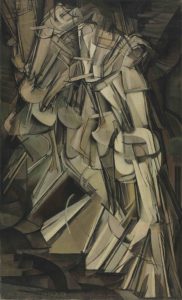Marcel Duchamp was one of the most influential artists of the 20th century.

Marcel Duchamp changed the course of art history. Challenging the very notion of what art is, his early readymades, such as Bicycle Wheel (1913) and Fountain (1917), shocked the art world. Duchamp believed that art should be guided above all by ideas, and thus became the father of Conceptual art.
About his life

Born on July 28, 1887, in Blainville-Crevon, France, he studied at the Académie Julian in Paris from 1904 to 1905. In 1911, he began hosting informal salons with his brothers Raymond Duchamp-Villon and Jacques Villon, inviting artists such as Francis Picabia, Robert Delaunay, and Roger de la Fresnaye, the group became known as the Section d’Or.
Duchamp refused to follow a conventional artistic path and did not appreciate repetition which explains the small number of works produced by Duchamp over his short career, leading to his retirement from the art world.
In the following years, Duchamp spent his time playing chess and working in secret on his latest enigmatic masterpiece, which was only revealed after his death on October 2, 1968, in Neuilly-sur-Seine, France.
Identity and key concepts

A performative act as a stylistic category, the term “readymade” coined by Duchamp himself designates the object of daily use produced in series, extracted from their usual context and promoted to the status of work of art by a simple choice of the artist.
Duchamp rejected purely visual or “retinal pleasure,” considering it easy, in favor of more intellectual, conceptual approaches to artistic creation. He undertook to experiment with kinetic devices, reflecting on the representation of movement and machines common to Futurist artists.
A taste for jokes and witty humor, full of sexual allusions, characterizes Duchamp’s work who also modeled puns with everyday expressions conveyed through visual means.
Nude Descending A Staircase (1912)
More than a study of the body’s movement through space, the oil painting is an early figurative exercise in painting cinematically, akin to Eadweard Muybridge‘s sequences of photographs that anticipated motion pictures.

image source: https://en.wikipedia.org/wiki/File:Duchamp_-_Nude_Descending_a_Staircase.jpg
Fountain (1917)
Fountain is a readymade sculpture: a porcelain urinal signed “R. Mutt” which orientation was altered from its usual positioning. Showing art primarily as a concept rather than an object is what would make Fountain arguably the most intellectually captivating and challenging art piece of the 20th century.

image source: https://en.wikipedia.org/wiki/Marcel_Duchamp#/media/File:Marcel_Duchamp,_1917,_Fountain,_photograph_by_Alfred_Stieglitz.jpg
Info source: https://en.wikipedia.org/wiki/Marcel_Duchamp
